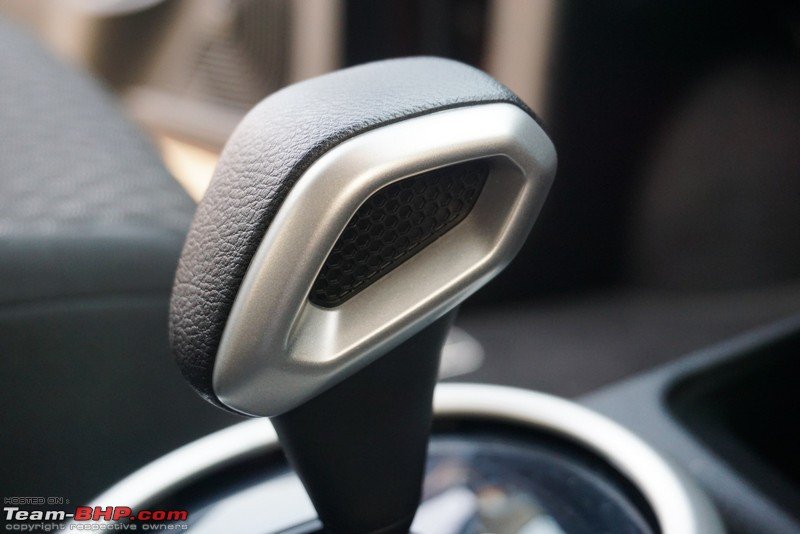| |||||||
| Search Forums |
| Advanced Search |
| Go to Page... |
 |
| Search this Thread |  308,608 views |
| | #1 |
| Team-BHP Support  Join Date: Apr 2016 Location: Mumbai
Posts: 1,829
Thanked: 21,715 Times
| 2021 Maruti Celerio Review Maruti Celerio ReviewThis review has been jointly compiled with Zappo. Thanks to him for the expert observations! 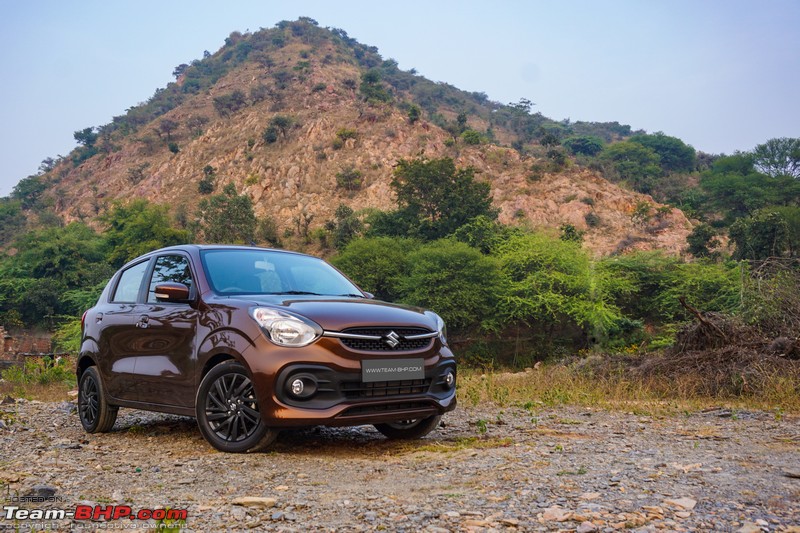 IntroductionThe name 'Celerio' needs no introduction. The 1st-gen car was launched at the 2014 Auto Expo and in just over a year, one lakh units were plying the Indian roads. Now, Maruti has brought in the 2nd-gen Celerio based on a new platform, with a new engine and a lot of other segment-first features. The Heartect platform is modular and underpins some other Maruti cars such as the S-Presso, WagonR, Swift, Ertiga. This is not the age-old Alto platform on which Maruti entry-level hatchbacks used to be based. Moreover, it gets the K10-C engine which comes with Dual Jet and Dual VVT with idle start-stop that aids fuel efficiency. This has allowed Maruti to make the claim that the new Celerio is the most fuel-efficient petrol car in India. In the B1 segment, it will compete against the likes of Hyundai Santro and Tata Tiago, but more importantly, it will be competing against its siblings - the S-Presso and WagonR, which is one of the best-selling cars in the country. Maruti Celerio Price & BrochureAs of now, Maruti has launched only a petrol version of the Celerio. A CNG version will be introduced soon. There are 4 variants on offer Ė LXI, VXI, ZXI and ZXI+. Prices start from Rs. 4.99 lakh for the base LXI variant and go up to Rs. 6.44 lakh for the ZXI+ variant. The AMT is offered on the VXI and above trim levels with prices starting from Rs. 6.13 lakh and going up to Rs. 6.94 lakh for the ZXI+. At these prices, the Celerio is positioned head-on against the Tiago. It is more expensive than the Hyundai Santro by a decent margin. Maruti really wants to get back the market share that the Tiago has carved out for itself with constant ~6,000 units per month. However, while the Tiago and Santro are the Celerio's direct competitors, IMO, the real battle is going to be between the WagonR and the Celerio. If you think about it, the WagonR is offered with the bigger 1.2L engine, which is powerful and fun to drive, has loads of space, is decently equipped and is approximately Rs. 50,000 cheaper than the Celerio. Yes, the audience for WagonR and Celerio would be different, but when it comes to sheer practicality, thatís where most people will want to go for the WagonR over the Celerio. What Maruti couldíve done, is offer the 1.2L engine alongside the new 1.0L (like in the WagonR) and price the smaller engined variants more aggressively. This would allow it to take on the Tiago on performance grounds as well (the Tiago makes 18 BHP and 25 Nm more than the Celerio). Additionally, it wouldnít confuse buyers and make them go for the WagonR instead. You can download the 2021 Maruti Celerio Brochure here - Maruti Celerio Brochure.pdf Maruti also has some funky accessory packs for the Celerio. You can download the accessories brochure here - Maruti Celerio Accessories Brochure.pdf Design & StylingIn its 2nd generation, the design of the Celerio seems to have evolved quite a bit. While the previous generation had a clean and neutral design with simple straight lines, this one is curvy. Right from the bonnet to the fenders and doors, the Celerio has smooth curves all over. The new Celerio is wider than the previous generation car by 55 mm and has a wider track as well giving it a squat stance. Overall, the elements work well, and while the design language is distinctive, IMO it just doesnít feel exciting enough. Yes, it has clean body lines and a nice stance, but itís still on the conservative side. That might appeal to the masses though. Build Quality, Fit & FinishThe Celerio is built on Maruti's Heartect platform thatís claimed to be lightweight, but highly rigid. The kerb weight for the base MT variant is 800 kg and the top-end AMT variant weighs 825 kg. Just for reference, thatís about 15-25 kg lighter than the previous generation car. This kerb weight is at par with the WagonR 1.0 (805-825 kg). Overall, the build quality is average. The panel gaps are slightly wider in some areas than others, but not very inconsistent. The doors are light and thereís flex in the panels as well. The paint quality is good and at par with the segment. Tataís paint shade on the recently launched Tiago NRG was of superior quality (reference image). The Celerio is being offered in 6 paint shades Ė Speedy Blue, Glistening Grey, Arctic White, Silky Silver, Solid Fire Red and Caffeine Brown (our test car). Wheels & TyresOnly the top-end ZXI+ variant is offered with 15-inch 'Urbane' black alloy wheels. These are shod with 175/60 section tyres. Our test car had Yokohama BluEarth FE tyres and the spare wheel was a 14-inch steel rim with 165/70 Bridgestone Ecopia tyre. All the other variants get the 14-inch steel rims with wheel covers. Interestingly, the recommended tyre pressure for both sizes was 36 PSI at the front and 32 PSI at the rear. Thatís exceptionally high pressure for the front tyres and most likely has been done to aid the fuel efficiency (more on this later). Ground ClearanceThe ground clearance is rated at 170 mm, which is good enough for Indian road conditions. In comparison with the competition, the Celerio rides higher than the Hyundai Santro (165 mm) and is equal to the Tiago. Standard & Extended WarrantyMaruti cars are offered with a standard warranty of 2 years / 40,000 km, which can be extended to 5 years / 1,00,000 km. We always recommend purchasing the maximum possible extended warranty available for added peace of mind. SafetyThe Celerio is equipped with quite a few safety features as standard like dual airbags, driver + passenger seatbelt reminder, ABS, headlight leveller and reverse parking sensors. Apart from this, you also get hill hold assist, speed-sensitive auto door locking, rear defogger and rear washer & wiper on select variants. Cabin Design & QualityThe dashboard design is quite different from what you would expect after looking at the car from the outside. Make no mistake, itís still a typical Maruti dashboard, but with multiple sharp elements. The all-black dashboard gets silver highlights to add a bit of contrast. There are no soft-touch plastics here, which is expected in this segment. The overall quality of parts is budget grade and compared to the Hyundai Santro, you can tell that compromises have been made. Space & ComfortThe doors open quite wide and getting in and out isnít much of a task. The seats are set at a good height and you wonít be dropping down into them. Thereís enough space for 4 adults and a kid to travel comfortably. The fabric seats are quite comfortable and provide good support too. However, the quality of the fabric is budget grade and similar to that of the WagonR. Driving Position & ErgonomicsThe top-end variant gets seat height adjustment, which has a good range. Even at the normal height, you get a good view of the road ahead. Moreover, you also get a glimpse of the bonnet from the driver's seat, which is something many drivers appreciate. The rearward visibility isnít that great due to thick C-pillars and the black plastic instead of the quarter glasses on the rear windows. Thereís no reversing camera on offer, so you will have to be careful in tight parking spots. Since the seat and steering are adjustable for height, finding your perfect driving position is quite easy. Most controls are well placed ergonomically. However, the centrally mounted power window controls and central locking button will take some time to get used to. Cabin StorageFront passengers get two cupholders and a cubbyhole to keep their stuff. The highlight of the storage is that all the door pockets can carry 1-litre bottles along with some knick-knacks. The glovebox is well sized and can carry some items other than the car's documents as well. The rear passengers have the front seatback pocket (left only), door pockets and a parcel tray to keep their items. FeaturesUnique & Noteworthy FeaturesThe Celerio comes with a relatively steep price tag and some of it is justified by the features on offer. You get request sensors for the front doors, electrically foldable ORVMs, a 60:40 split rear seat, remote key, engine idle start-stop and hill hold assist for the AMT variants. Audio System & Sound QualityThe Celerio comes equipped with Marutiís Smartplay studio system with smartphone navigation on the top-end ZXI+ variant. You also get Android Auto and Apple CarPlay connectivity with the system thatís connected to 4 speakers. The touchscreen infotainment is very user-friendly and doesnít have lag. Itís slick to operate, but the audio system is sub-par. It does not come close to the music system of the Tiago. Rear Seat Comfort & SpaceJust like the front, getting into the rear seats isnít a cumbersome affair. Once inside, thereís a good amount of space on offer. At 5'10", I was easily able to sit behind my own driving position. Two six-footers behind each other might find it to be a bit snug, but not uncomfortable. Thereís decent headroom available when youíre sitting upright, but try and relax on the headrest and your head would be quite close to the roof. The cabin width is decent for two fit adults and a child. However, three healthy adults would definitely have problems here. The backrest angle is nice and comfortable and the overall back support is satisfactory too. The headrests are not adjustable, which is not uncommon in this segment. However, their position is too low for my liking. For my height (5'10"), the base of the headrest was too low which made it uncomfortable. The rear windows get a black plastic cover towards the end which obstructs visibility. A quarter glass here wouldíve helped a lot. Thereís no rear armrest or AC vent or charging point for rear passengers. Boot SpaceAt 313 litres, the Celerio has a bigger boot than the Santro (235 litres) and the Tiago (242 litres) as well. Itís quite an accommodating boot and in case you want more luggage space, you can fold down the seatback down in a 60:40 ratio. |
| |  (54)
Thanks (54)
Thanks
 |
| The following 54 BHPians Thank Omkar for this useful post: | AheadAJ, Akshay6988, arjab, Arnav Vaghela, ArTigor, ashis89, Autocaptive, CARDEEP, CEF_Beasts, chinmaypillay, CrAzY dRiVeR, dailydriver, digitalnirvana, espraveen, fireblade007, FlashMustang, FloatingCanvas, Gannu_1, GaryTSI, Geo_Ipe, GTO, g_sanjib, haisaikat, hemanth.anand, KuvamBansal, lemedico, mh09ad5578, MSAneesh, muqtaliff, Osteon206, Ponbaarathi, PrasunBannerjee, procrj, RavenAvi, Reinhard, Researcher, rj22, romil.shroff, Roy.S, Rshreyansh, S.MJet, samaspire, SatishBisht, SgtRuckus, shancz, silverado, SulemanP, swiftnfurious, theexperthand, vb-saan, Vignesh Vee, Vinod_nair, yogiii, ysjoy |
| |
| | #2 |
| Team-BHP Support  Join Date: Apr 2016 Location: Mumbai
Posts: 1,829
Thanked: 21,715 Times
| Driving the Maruti Celerio 1.0L Petrol MTThis is the 998 cc, 3-cylinder, 12V DOHC, all aluminium K10-C petrol engine that has been introduced with the Celerio. It churns out 66 BHP @ 5,500 rpm and 89 Nm @ 3,500 rpm. Like the previous versions of the K10, this engine is peppy and quite enjoyable to drive. But, we would have liked to see the 1.2-litre engine here, since the Heartect platform can accommodate it quite easily. 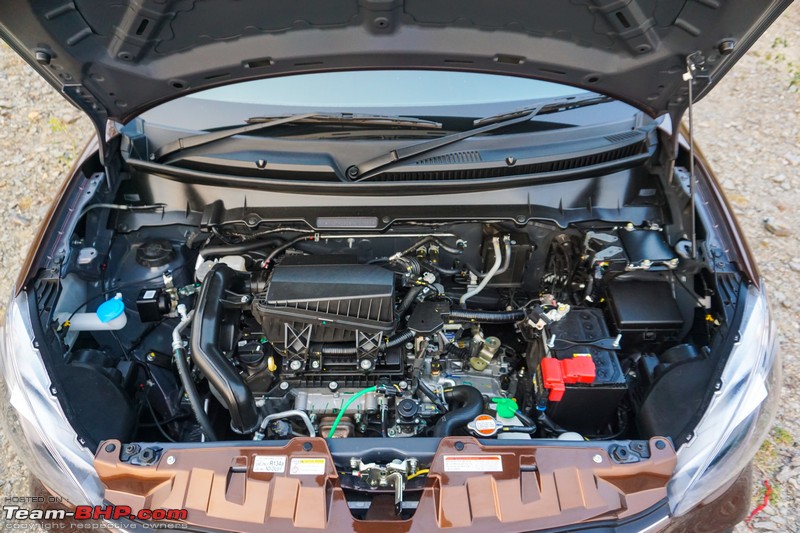 Weíve mentioned before that the Celerio is powered by the K10-C engine, but what exactly is different compared to the 'B' series engine that weíve seen in the S-Presso and the WagonR? For starters, there are two notable additions Ė Dual Jet and Dual VVT. This means that there are two injectors (Dual Jet) per cylinder that spray fuel into the combustion chamber. Having two injectors leads to better atomisation and thereby cleaner combustion. It also means that the compression ratio has also gone up from 11 in the K10B to 11.5 in the K10C. VVT or variable valve timing adjusts the valve timing to increase fuel efficiency and in a 'dual' VVT system, both intake and exhaust valves are adjusted to maximise fuel efficiency and performance. The engine also gets a water-cooled EGR (exhaust gas recirculation) system. While most compression ignition (diesel) engines use EGR to reduce emissions, in spark ignition (petrol) engines, EGR actually helps in increasing efficiency. Apart from this, Maruti has also added an idle start-stop system that shuts off the engine while idling, which also helps the fuel efficiency. With your leg on the clutch pedal, press the start/stop button to bring the engine to life. Release the light clutch and the Celerio rolls off from a standstill with ease. It can easily move away from 0 km/h in second gear too! Driveability is excellent and the light kerb weight makes things easy for this little 1.0. The motor feels very tractable in the city and itís got a practical state of tune. The healthy low-end & perfect gearing means you do not have to downshift too often. Driving around in the city wonít be much of an issue for this small hatchback, in fact, it feels very much at home. Out on the open road is where you would wish that this car had the 1.2-litre engine. Donít get me wrong, the 1.0 engine performs alright and has all the traits that you would expect of a K-series motor. But, after having driven the WagonR 1.2, which is not much heavier, you will be left longing for the bigger engine (especially when it is available for lesser money). The Celerioís 83 BHP / ton power-to-weight ratio makes a big difference here (WagonR = 99 BHP / Ton). Even the S-Presso feels more lively given that itís ~ 100 kg lighter (92 BHP / ton). Compared to these two, the Celerio feels just about okay in terms of highway performance. Cruising at 100 km/h in 5th gear, the motor spins at ~2,750 rpm, while 120 km/h is seen at ~3,250 rpm. For quick overtaking manoeuvres, while cruising at 100 km/h, you will have to shift down to 3rd gear as thereís not much progress when you floor the A-pedal in 4th gear. Itís best to cruise between 90-100 km/h in 5th gear. The tall 3rd gear and occasional downshifts to 2nd would take care of your pedal-to-metal driving when on twisty roads. Overall, the motor responds well when pushed hard, but leaves you wanting for more. The clutch is nice and light to operate, with just the right travel length. The 5-speed gearbox is good to use with throws on the shorter side. Itís a pleasure to operate, even if it is slightly rubbery. Noise, Vibration & Harshness (NVH)Since this is the new platform, Maruti has gone for a pendulum type engine mounting system rather than the conventional 3-point mounting system from the previous generation Celerio. This has in turn made a lot of difference in reducing the engine vibrations. Heck, the 3-cylinder doesnít even have a balancer shaft and still, the vibrations are well controlled. At city speeds, the engine noise is kept under control and isnít intrusive. But as the revs climb, the engine does sound strained and IMO itís not very sporty like most enthusiasts enjoy. Cross 80 km/h and the road noise and wind noise started to creep into the cabin and at 100 km/h, theyíre very audible. Whatís worse, while driving over broken roads, youíll hear pebbles hitting the inside of the wheel arches (as there is partial / no cladding). Mileage & Fuel EconomyMaruti has done a lot of things to maximise the fuel economy. The ARAI-certified fuel economy of the Celerio MT (LXI, VXI and ZXI variants) is 25.24 km/l while that of the ZXI + variant is 24.97 km/l. With the AMT gearbox, the fuel economy is 26.68 km/l for the VXI variant. The ZXI and ZXI+ AMT variants have a fuel economy of 26 km/l. This engine is known for its frugality & will give owners no reason to complain. Driving the Maruti Celerio 1.0L Petrol AMTThe previous generation Celerio was the first Maruti car to get the AMT or as Maruti calls it, 'Auto Gear Shift' in India. The 2021 Celerio gets the latest generation Magneti Marelli sourced AMT unit for its 5-speed manual transmission which is available in the VXI, ZXI and ZXI+ variants. The AMT mechanism is a simple bolt-on job and uses the Celerio MT's existing gearbox. Itís pretty straightforward in the way it works. Mechanically, the AMT gearbox is identical to the Celerioís manual transmission. What's different is how the clutch is operated and how the gears are shifted. In the manual, the driver is responsible for these tasks. With the AMT, hydraulic actuators located in the engine bay operate the clutch and shift gears. There's no clutch pedal, and zero driver input is required for gearshifts, making it exactly like a conventional automatic to drive. Simply put, the mechanical functions of operating the clutch and gear lever have moved from inside the cabin to the engine bay. To know more about AMTs & how they work, click here. Starting the engine up must be done with the gear lever in neutral. You have to press the brake pedal as well, else the engine won't fire up. There's no 'P' (park) mode or gear unlock button like in a conventional AT. Once fired up, slide the gear lever to 'D' (drive) to get going. As you release the brake, the car will move forward without any accelerator input. However, it doesn't move too fast and will top out at about 6-7 km/h, without any driver input. When you press the accelerator, you'll notice that the throttle response is quite immediate. It's exactly like a pure manual in this respect. In city, traffic is where the AMT truly shines and brings the most benefits. There's no clutch pedal and there's no requirement for the driver to repeatedly shift between Neutral-1st-2nd either. In crawling bumper to bumper traffic, you don't need to give any accelerator input. Just release the brake a little bit, and the car crawls forward. The start-off is extremely smooth. Budget car owners will love the fact that their left leg is completely relaxed. The tricky part with the AMT in city driving though is parking into tight spots. Unlike a conventional AT where it's possible to ease the car forward very gradually, the AMT is more of an 'on or off' solution, as it tries its best not to slip the clutch more than required. This results in a more eager movement, which can be a bit tricky when getting in & out of tight parking spaces. Gear-shifting quality is a universal sore point for Automated Manual Transmissions. The Celerio's AMT unit which is the improved version of the previous generation is actually very good. In fact, it seems like Maruti has finally caught up with Hyundai Santroís smooth-shifting AMT. With a light foot on the accelerator, the gearshifts are barely noticeable. First-time automatic drivers won't have any complaints with the AMT. Itís only when you are driving with a heavy foot that the shifts are noticeable in the form of the typical head-nod. People who are used to driving AMT cars will like this unit for sure. One of the ways to make your drive even smoother is to let off the accelerator at intervals, and the AMT will seize that opportunity to upshift. E.g. When going from 0-40 km/h, let off the accelerator very slightly at 10, 20 and 30 km/h, and the AMT will take each one of those opportunities to upshift a gear - almost like you told it to! Shift quality gets better between higher gears and is virtually seamless when going downhill. The AMT unit is smooth even while downshifting. While I was driving, I asked Zappo to spot the downshifts without looking at the tachometer. The downshifts were so smooth that he didnít feel them from 5th gear to 3rd while decelerating gently. There's absolutely no noise or clunking when the gears shift. Fuel efficiency is without a doubt what the AMT has been tuned for. This means the transmission is very eager to upshift and before you know it, you will be cruising along in 5th gear at 50 km/h. Even in crawling traffic, the AMT will upshift to 2nd gear at fairly low speeds. When the rpms drop, the transmission will downshift to a lower gear. The 'current gear indicator' on the MID keeps you in the loop as to which gear is engaged. It's quite a novelty and will be appreciated by prospective and existing owners of the Celerio AMT. The idle start-stop feature in the AMT variant can get annoying in bumper to bumper traffic. While it does maximise the fuel economy, the system shuts off the engine quite quickly and does take time to start up and get a move on. Only people who seriously want to get the most out of the fuel would be using this feature. The engine gives out a nice blip on kick-down and doesn't hesitate to drop two ratios at a time (e.g. 5th to 3rd). With a heavy foot on the accelerator, the AMT holds a gear all the way till the end of the rpm range before upshifting. The driver also has an option of 'manual mode' to prevent premature upshifts while overtaking on highways. Manual Mode has other advantages, especially for the more enthusiastic drivers who want a higher degree of control. Like other hatchbacks with AMTs, the Celerio offers a Tiptronic-like manual mode. Towards the right of the MID gear indicator, there is a small alphabet readout: 'M' for Manual & 'D' for Drive, indicating the mode that you are currently in. In manual mode, the AMT will still not upshift automatically unless you reach the end of the rpm range. Conversely, if the rpm drops too low, the AMT will downshift to prevent the motor from stalling. If you try to upshift at too low an rpm or downshift at too high an rpm, the AMT will ignore your instructions and flash the gear indicator in protest. It's always a good idea to switch to manual mode before your favourite ghat section because it prevents sudden & unsettling gear changes mid-corner. An advantage of manual mode is that you can increase the amount of engine braking when going downhill. It's quite effective, although not as aggressive as in a pure MT. We recommend shifting to manual mode before overtaking when you need engine braking and of course, the times that you are in the mood for some fun. The AMT unit is equipped with an extremely useful Hill Start Assist feature. Whatís more impressive is that this isnít the basic hill start assist feature that you see in most budget AMT units where the hill start assist is essentially an extension of the creep function. In such cases, the car rolls back at least a foot before going ahead. In the case of the Celerio, however, this is a proper hill start assist feature that will engage the brakes and hold the car in place on a slope. Be it a gentle incline or a steep one, the Celerio doesn't roll back an inch. Very impressive! Unfortunately, the same function isnít offered in the MT variants. Technically speaking, it shouldnít have been much of a pain to add the same system in the MT variants, especially if it's not a bare basic creep extension hill hold assist. It'll prove to be very useful for newbie drivers who otherwise will be burning up the clutch on steep inclines. I'd also like to add that the AMT manages the clutch & gearbox a lot better than sub-par drivers out there. There's no doubt that it is more talented than a below-average driver in choosing when to shift, how to shift and what gear to drive in. Ride ComfortThe Celerio comes with a MacPherson strut suspension at the front and a torsion beam with coil springs at the rear. While most of the other cars that are based on the Heartect platform have a softer front suspension, the Celerio has a slightly stiffer side to it. Small bumps are felt, while large potholes register themselves sharply in the cabin. The suspension isn't silent in its operation either, and you can hear it work on a patch of bad road. The 15-inch rims are shod with 175/60 tyres. The recommended tyre pressure is 36 PSI at the front and 32 PSI at the rear. Thatís unusually high for the front and is also one of the contributors to the stiff ride. We would recommend dropping it down a little for a cushier ride in the city. With the slightly stiffer suspension, however, vertical movement at high speeds is well controlled and the car doesnít bounce around at 80-100 km/h. Handling & DynamicsAs you would expect with a stiffer suspension setup, the straight-line stability is satisfactory. Driving at 120 km/h also doesnít feel as daunting as it would in the previous generation Celerio. People taking the car on long road trips wonít be disappointed. A low centre of gravity also means that the body roll is well controlled. On long bends, the Celerio holds its line well without feeling nervous. Quick lane changes are also handled very well and the car seems eager to change directions. When pushing the car hard, you will notice that the chassis and the suspension can easily handle a lot more than 66 BHP available. The 175/60 R15 Yokohama BluEarth FE tyres on our test car provided decent grip. SteeringThe electric power steering in the Celerio is one-finger light during parking and city speeds. This makes it a very easy car to drive in urban surroundings. However, it can also be unnerving as some might feel the steering is too light and vague in the centre and you get no feedback at all. Itís pretty much dead like a video game steering. The mass market will like it though. At higher speeds, the steering does weigh up, but the complete lack of feel or feedback can be unnerving. Like the steering in most Maruti cars, there is no strong return to centre action. Leave the steering at a slight angle while driving and you will keep on going in that direction. You have to manually straighten it. BrakingThe Celerio is equipped with disc brakes at the front and drum brakes at the rear. The brakes perform well and as you would expect without any drama. I wish there was a more progressive feel to the brakes though. Niggles & ProblemsThe previous generation Celerio had quite a few issues with the AMT unit. Hopefully, the newer generation Magneti Marelli AMT unit isnít riddled with problems. Apart from this, Maruti has a wide service network and part availability is never much of an issue. So ownership experiences should be satisfactory. That being said, get the extended warranty without giving it a second thought. Last edited by Aditya : 17th November 2021 at 09:01. |
| |  (42)
Thanks (42)
Thanks
 |
| The following 42 BHPians Thank Omkar for this useful post: | AheadAJ, Akshay6988, Arnav Vaghela, ashis89, Autocaptive, CARDEEP, CEF_Beasts, chinmaypillay, CrAzY dRiVeR, deep_behera, Dr.AD, Dr.Naren, espraveen, FlashMustang, FloatingCanvas, Gannu_1, giri1.8, GTO, g_sanjib, hemanth.anand, KuvamBansal, Mustang Sammy, PM - B, rajesh1868, rajk15, RavenAvi, red_nemesis, Reinhard, Researcher, Rshreyansh, S.MJet, SatishBisht, Sayan, shancz, sharan_si, SulemanP, swiftnfurious, t3rm1n80r, theexperthand, vb-saan, Vignesh Vee, ysjoy |
| | #3 |
| Team-BHP Support  Join Date: Apr 2016 Location: Mumbai
Posts: 1,829
Thanked: 21,715 Times
| Maruti Celerio Exterior ImagesWhile the previous generation Celerio had very neutral looks, this is more love it or hate it design. Small grille with two chrome lines lead up to the Suzuki logo in the centre: 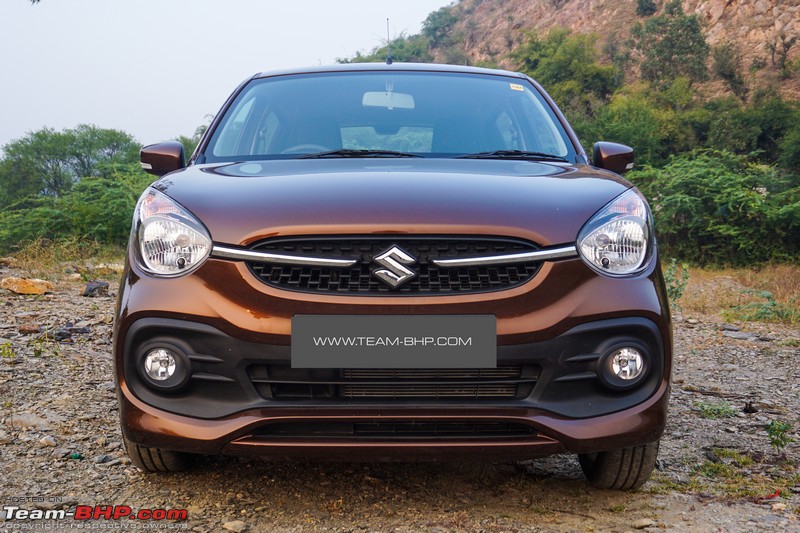 The simple rear-end design looks very much like the old Alto. Tail-lamps go well with the design: 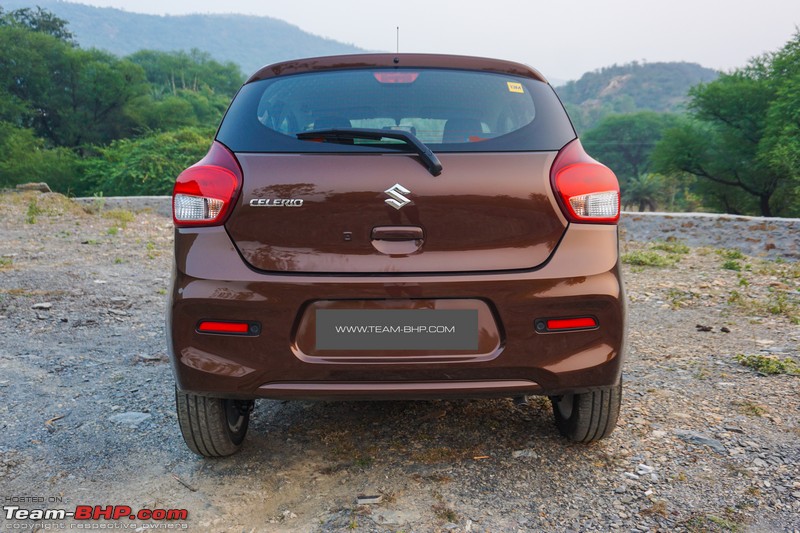 From the side, the Celerio looks very contemporary. Round wheel arches are nicely filled by 15-inch alloy wheels: 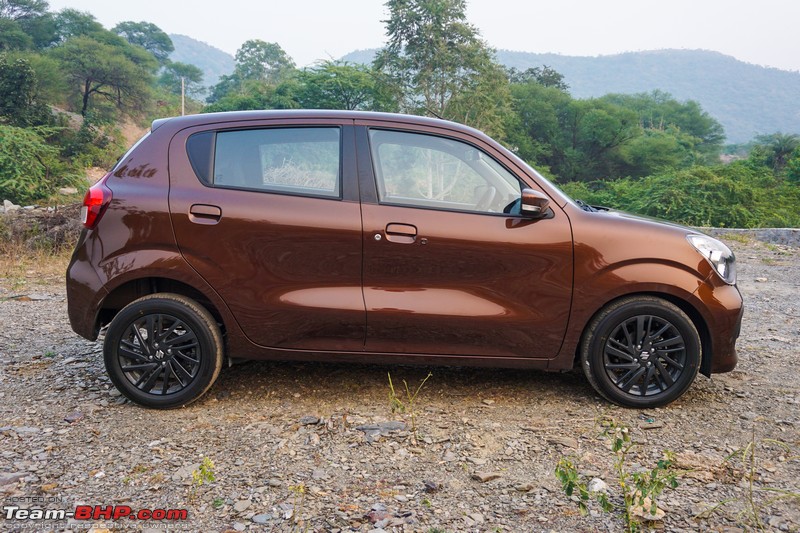 The Celerio measures 3,695 mm in length, 1,655 mm in width and 1,555 mm in height with a wheelbase of 2,435 mm. It is wider than before and that gives the car a planted stance: 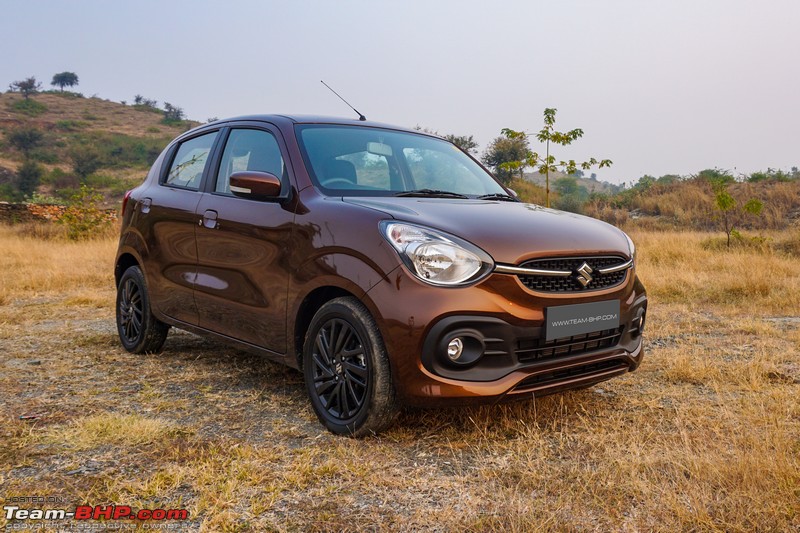 Our test car is seen wearing the Caffeine Brown paint shade. Curvy body lines look good on the Celerio and flared wheel arches add a sense of muscularity to the design: 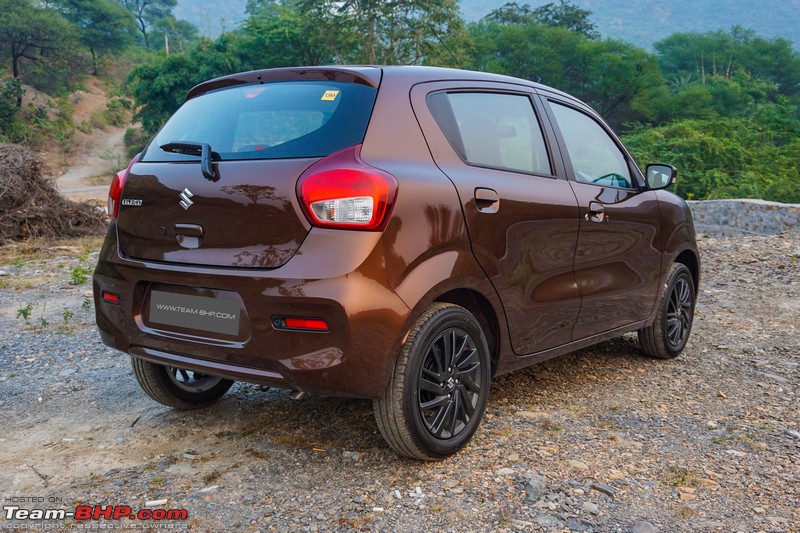 Very Ford Figo-like headlamp design. Simple halogen unit has a decent throw and also gets a manual leveller. No, there are no DRLs here: 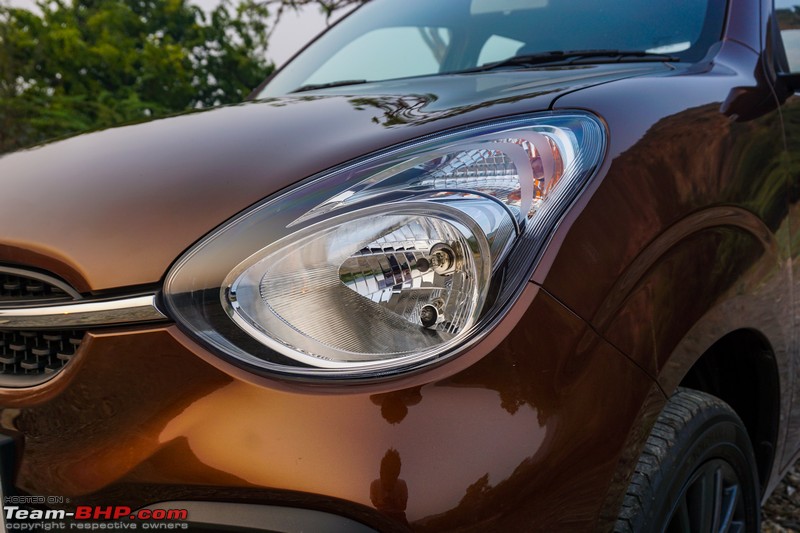 The lower bumper has this black applique running across its width which houses the air dam and fog lamps. Thereís also a body-coloured lower lip below the air dam: 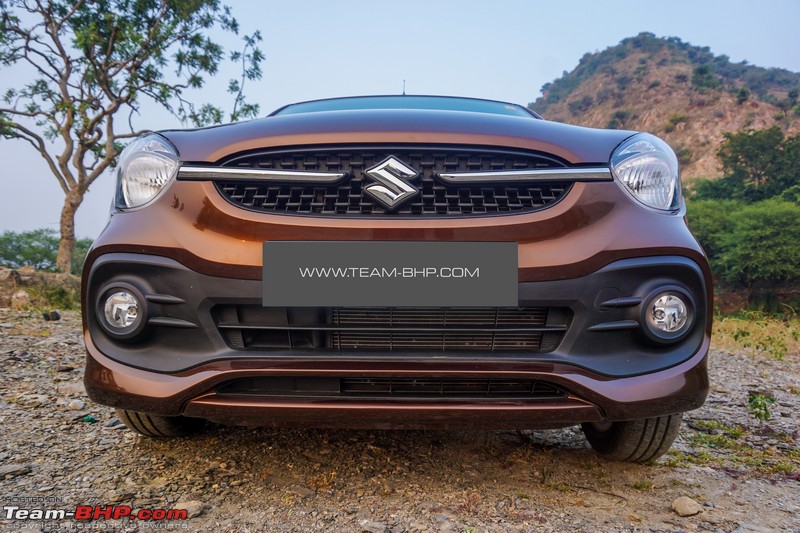 No underbody protection, not even a plastic cover. See the black rod and wire mechanism next to on the right side of the picture? Thatís actually a clutch actuating mechanism. Such a moving part should get a good amount of protection for sure, no matter how high the ground clearance of the vehicle is: 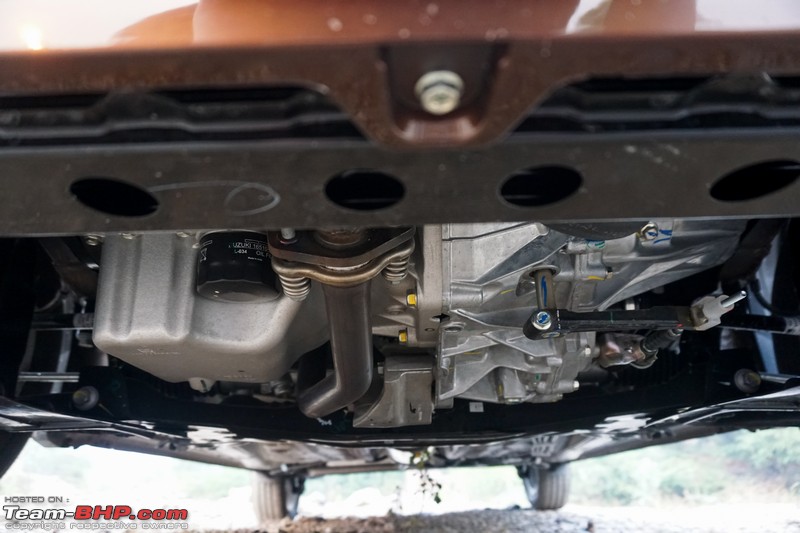 Itís been quite some time since we saw such a simple and smooth design for the bonnet. There are two subtle creases on the sides: 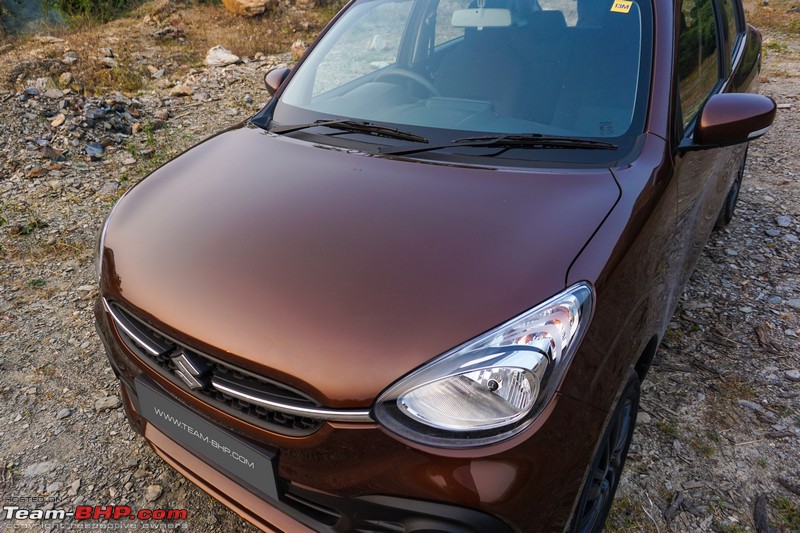 Body-coloured ORVMs with integrated turn indicators. They are electrically foldable and even close when you lock the car. Nice! 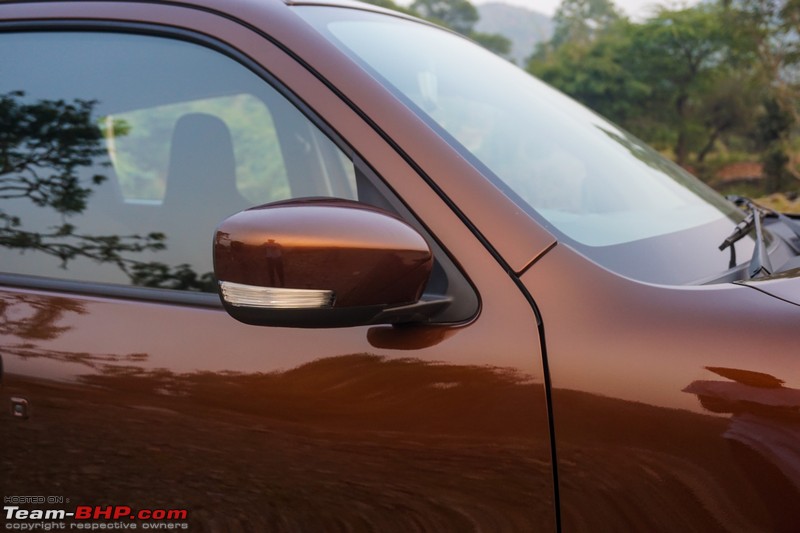 Flap-type door handles look outdated next to the request sensors for keyless entry. Keyhole is located on the door rather than on the door handle: 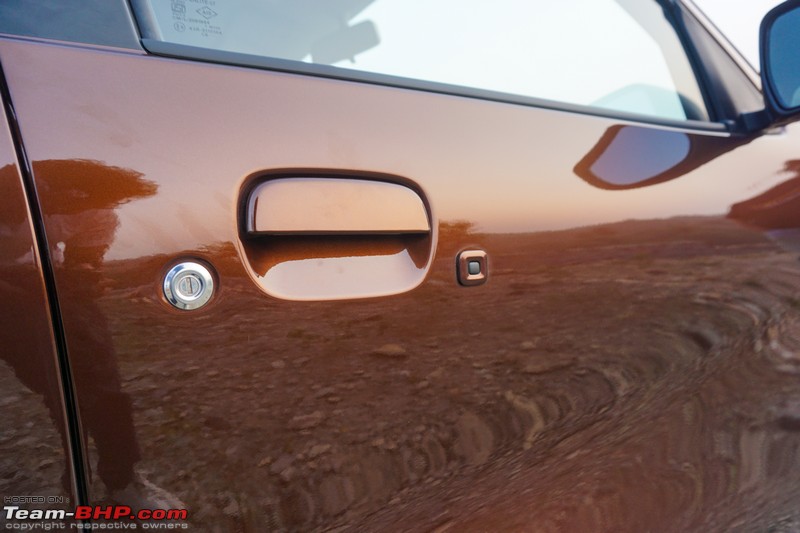 Glass area is adequate, but a rear quarter glass wouldíve been a nice addition. Blackened B-pillar is a nice touch: 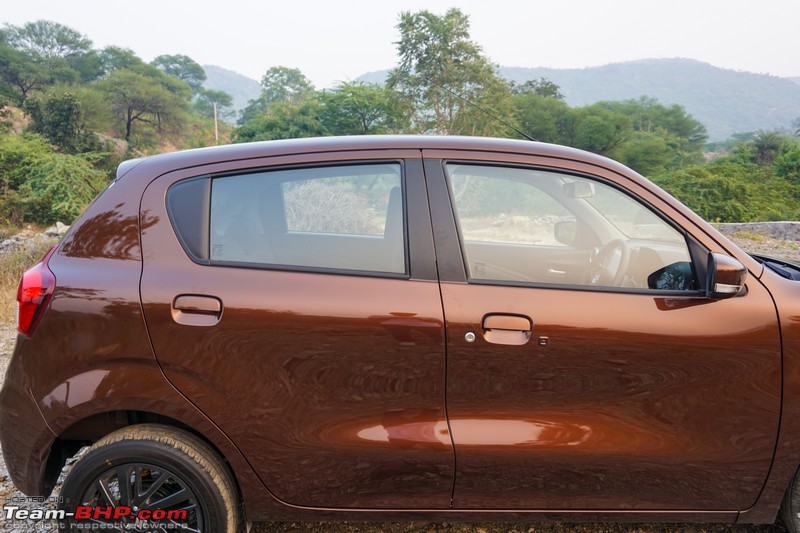 15-inch black alloy wheels have a funky design and go well with the look of the car. Theyíre shod with 175/60 section Yokohama BluEarth FE tyres. Thereís very little wheel cladding present in the front wheel well: 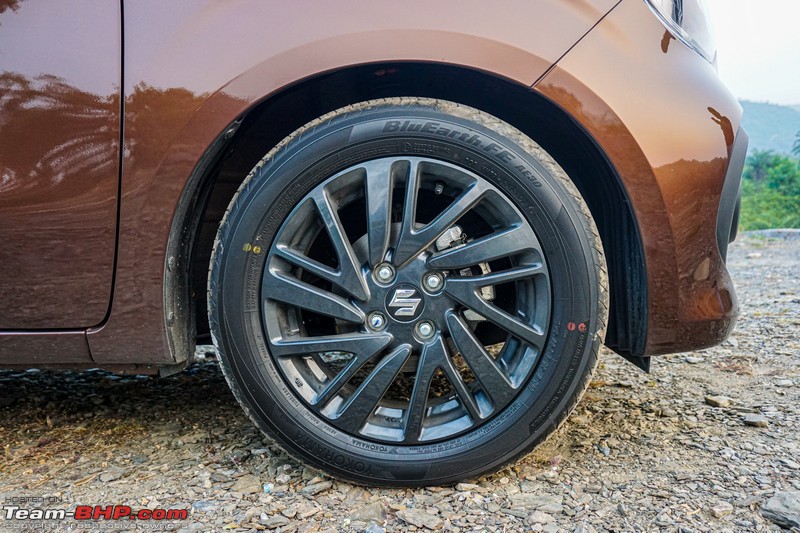 Drum brakes at the rear. You can clearly see that thereís absolutely no cladding in the rear wheel wells: 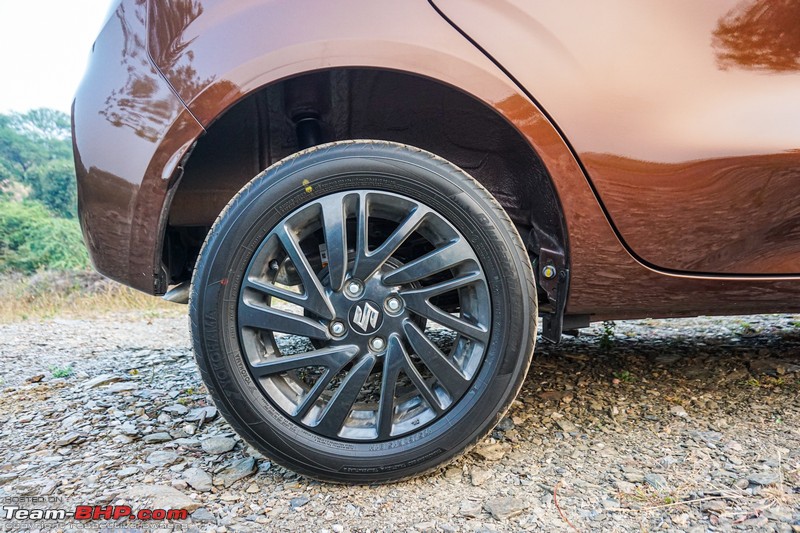 Long antenna is placed at the front. The previous generation Celerio had a ribbed roof (reference image), but not this one: 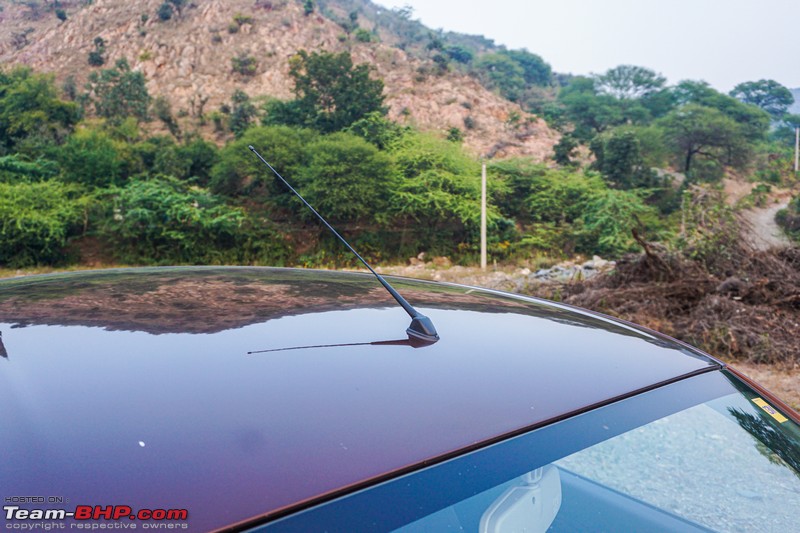 ZXI and ZXI+ variants get a rear washer + wiper along with a defogger: 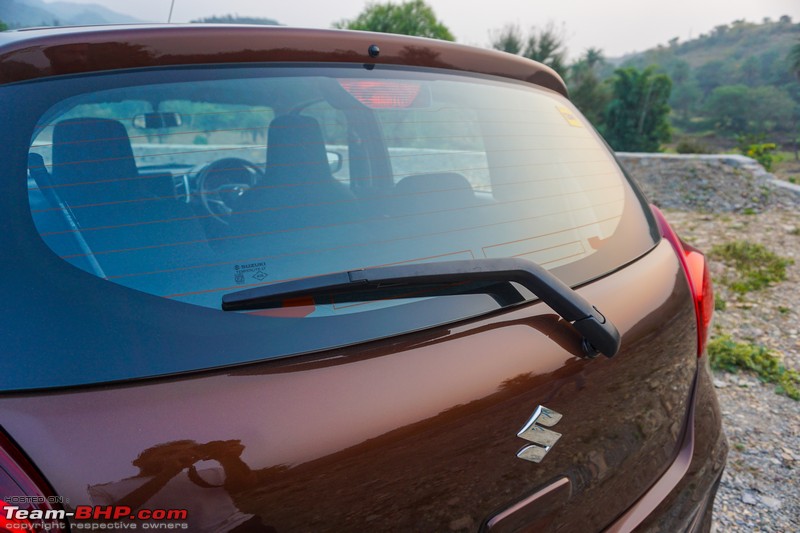 With all the lights in action. Brake lights are placed on top with indicators and reversing lamps placed at the bottom. Yes, the Celerio gets two reversing lamps: 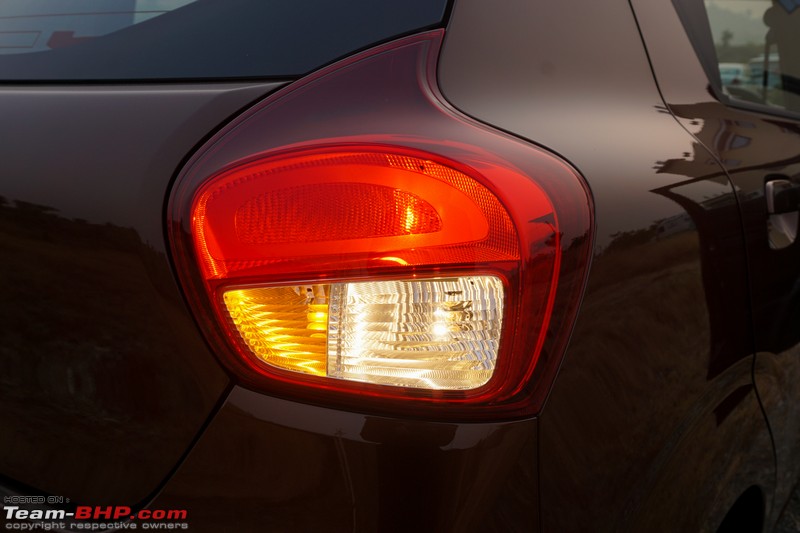 Tailgate also gets a request sensor and the flap-type door handle: 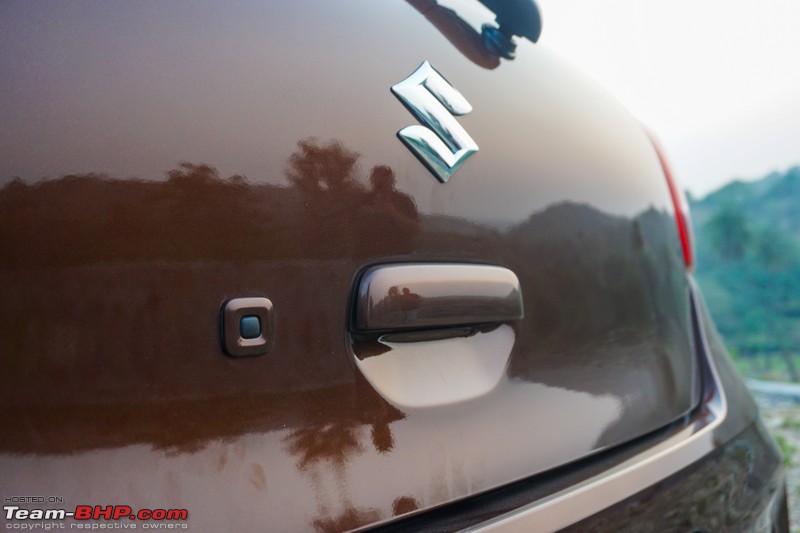 Reverse parking sensors are standard across all variants. Theyíre nicely integrated into the reflectors. There's no variant badge on the tailgate: 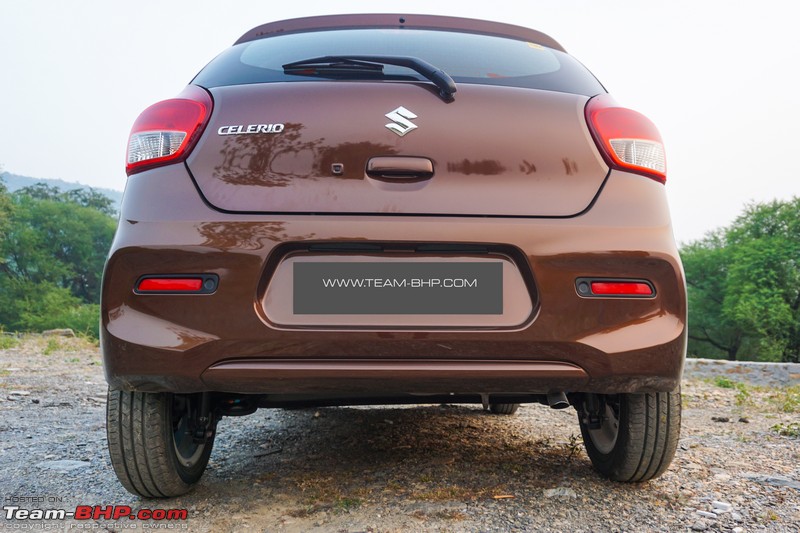 Rear suspension uses a torsion beam setup. Towing eye is located beside the exhaust on the right side: 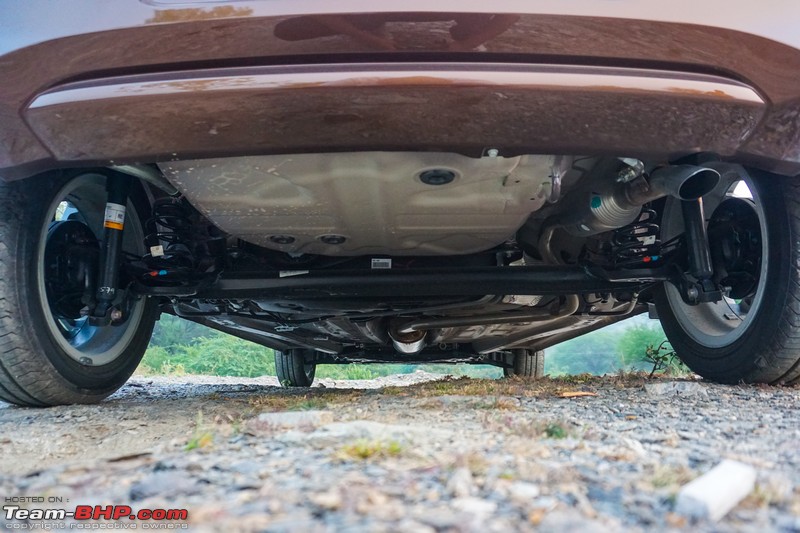 Fuel tank capacity is 32 litres: 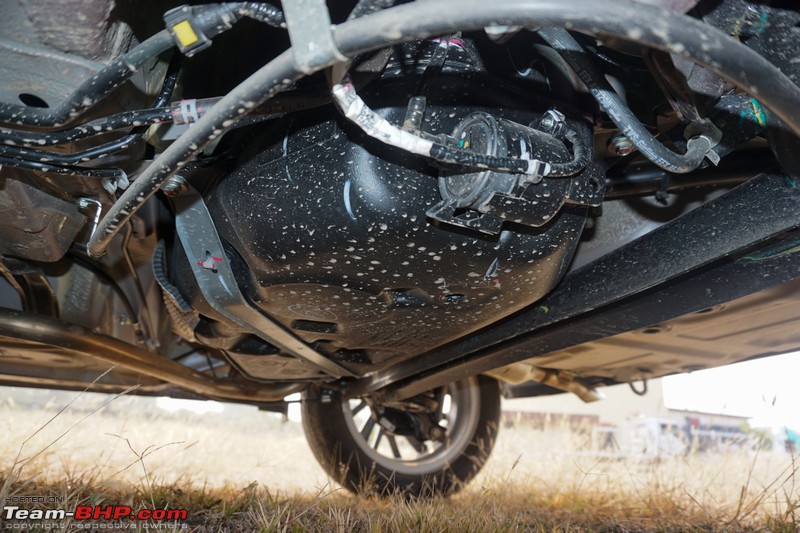 Hereís a look at the car in the Speedy BlueÖ 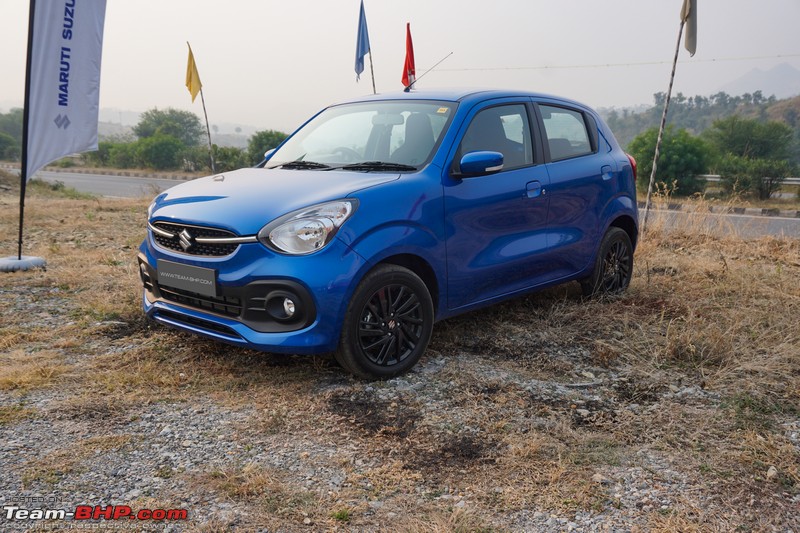 Ö and in Solid Fire Red: 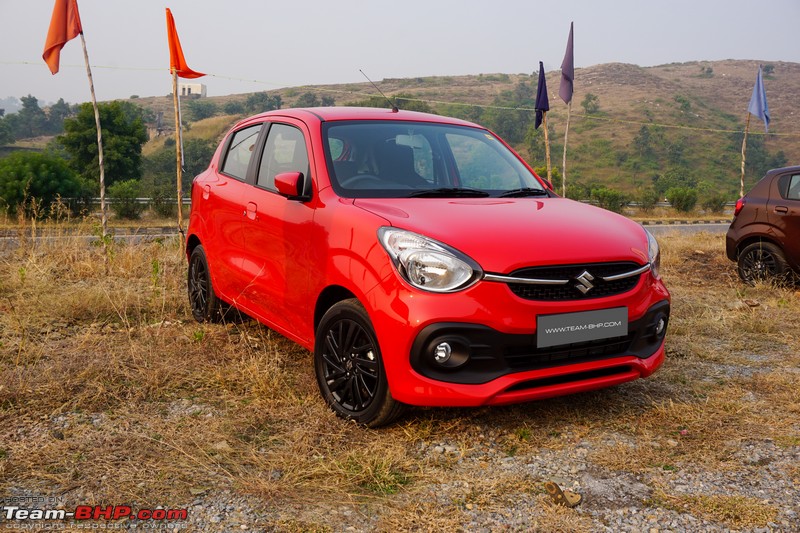 Last edited by Aditya : 17th November 2021 at 09:02. |
| |  (42)
Thanks (42)
Thanks
 |
| The following 42 BHPians Thank Omkar for this useful post: | 2himanshu, advenk999, AheadAJ, Akshay6988, ashis89, AYP, blackwasp, CARDEEP, CEF_Beasts, chinmaypillay, CrAzY dRiVeR, deep_behera, Dr.AD, espraveen, FlashMustang, FloatingCanvas, Gannu_1, GaryTSI, GTO, haisaikat, hemanth.anand, icar, Leoshashi, MSAneesh, muqtaliff, PM - B, RavenAvi, Reinhard, Researcher, ron178, Roy.S, Rshreyansh, S.MJet, samaspire, SatishBisht, shancz, SulemanP, t3rm1n80r, theexperthand, vb-saan, Vignesh Vee, ysjoy |
| | #4 |
| Team-BHP Support  Join Date: Apr 2016 Location: Mumbai
Posts: 1,829
Thanked: 21,715 Times
| Maruti Celerio Interior ImagesAll-black dashboard has a contemporary design and reminded Zappo of the Hyundai Verna's (fluidic) dashboard with its 'V'-like shape:  Steering wheel is shared with the WagonR. The wheel size and thickness are spot on and it feels great to grip and operate. Horn pad is large and easy to press, but those with smaller fingers will find it a stretch to reach it: 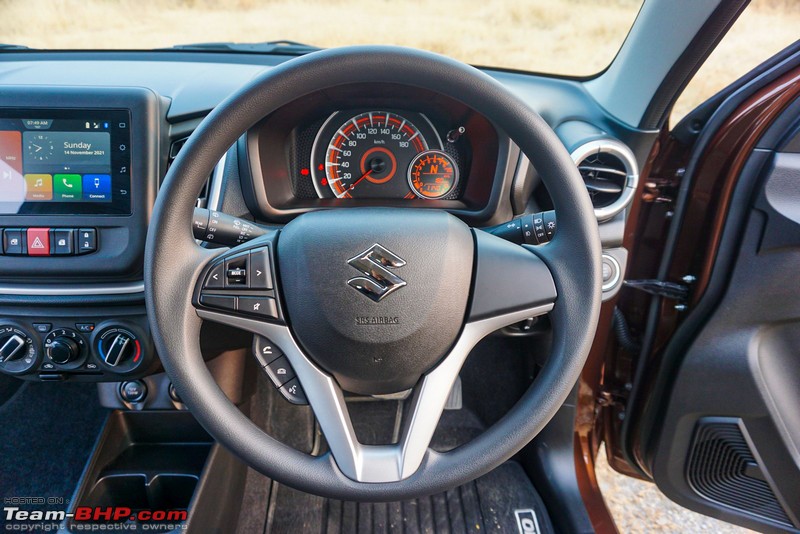 Buttons to control the infotainment system are on the left side, while the right is blank. The buttons are easy to operate and provide decent feedback. A mute button has also been provided. Call answer / disconnect and voice command buttons are placed down below. You have to press these buttons instead of pulling them towards you: 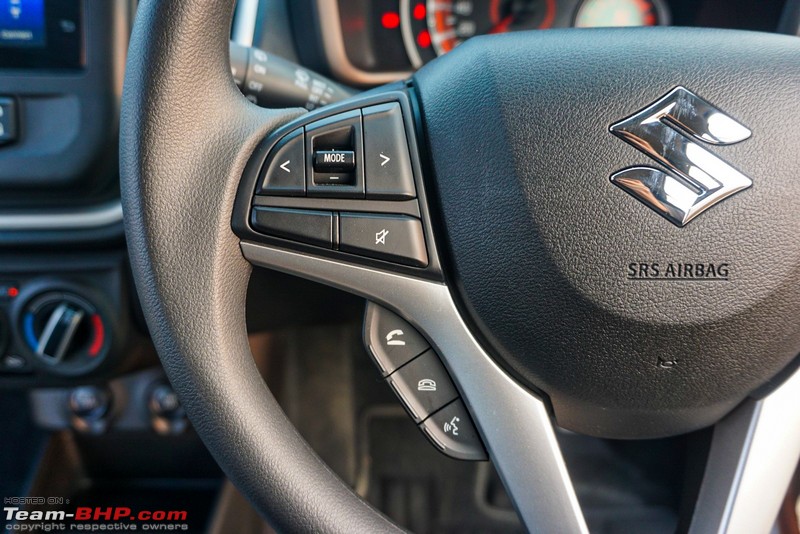 Stalks are chunky and nice to use, but don't feel as nice as the Santro's. Front and rear wiper controls are on the left, while light controls are on the right stalk. Foglamp switch is integrated into the light stalk: 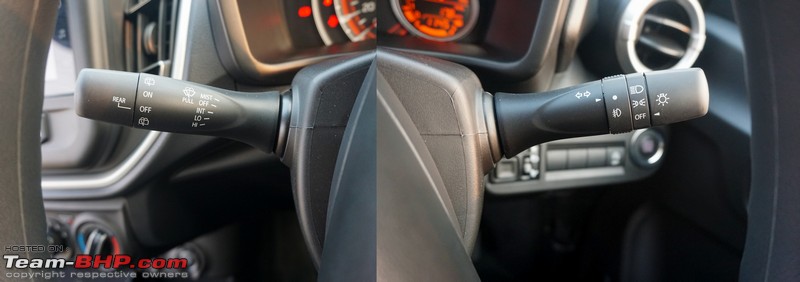 On the driver’s right-hand side you will find the mirror adjustment controls (along with the folding switch) and next to it, there’s a set of dummy buttons along with the Idle Start Stop OFF switch. Right beside it, there’s the engine start-stop button which gets a chrome ring around it:  Instrument cluster layout is similar to the one in WagonR but gets a different background design. It is easy to read and is dominated by a large speedo in the centre. Circular dial on the right houses the digital rev counter, fuel gauge, clock and the single line MID, but no temperature gauge has been provided. Numerals of the speedometer are backlit in white, while the MID cluster gets orange lighting. Digital tachometer shows rpm in multiples of 250, and the MID gets 2 trip meters. It also displays average and instantaneous fuel efficiency and distance to empty: 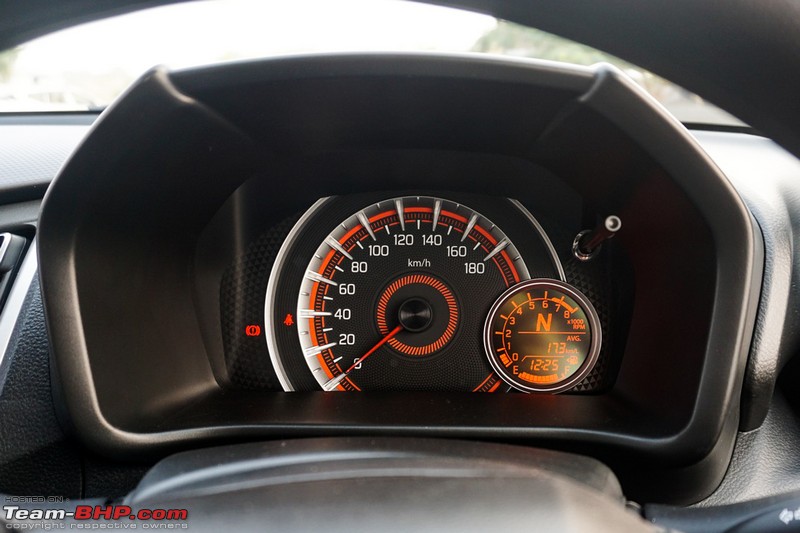 In the AMT variant, the current gear position is displayed on the top:  Circular air vents with the brushed silver border look very budget grade:  All-black doorpads are very practical. Power window switch controls have been moved to the dashboard from the doorpads. It would’ve been nice to see some fabric near the armrest area:  Door pockets can hold a 1-litre bottle along with some other knick-knacks:  Front seats are upholstered in fabric and have a good amount of bolstering on the backrest as well as the seat base. The seats could have been a tad firmer so that they would be more suitable for long distance drives. Under-thigh and lower back support offered is sufficient and the integrated headrests are well-positioned and suitable for all:  Driver's seat height adjustment has a healthy range. However, it’s only offered on the top-end ZXI+ variant:  The standard Maruti A, B, C pedals are well spaced out. A dead pedal has been provided. While it could have been wider, it is useable. Also, note the bonnet opening lever on the right and manual headlamp leveller on the top:  Here’s a look at the pedals in the AMT variant. No clutch pedal means more space in the footwell:  Electrically adjustable ORVMs offer a sufficient view of things behind. These close when you lock the car:  From the driver’s seat, you get a good view of the road ahead. You also get to see a glimpse of the bonnet which is something a lot of drivers appreciate:  Tiny IRVM just about covers the rear windshield. Manual day/night adjustment is offered on all variants except the base:  Rearward visibility is restricted by thick C-pillars and the black applique on the rear windows:  Centre fascia is dominated by a 7-inch touchscreen head-unit that gets a brushed silver outline. Gear lever is placed towards the driver:  Central air vents are placed on either side of the touchscreen and have a funky design. You cannot shut these air vents completely. The front power window switches and central locking buttons are placed just below the touchscreen. This is a cost-effective solution and does take some time to get used to:  The ZXI+ variant gets a 7-inch touchscreen head-unit dubbed the 'SmartPlay Studio 2.0'. Connectivity is through Bluetooth, USB and AUX-in. Voice commands, Apple CarPlay, and Android Auto are supported as well. A CD player is missing, though when was the last time you used one? Maruti has provided a couple of apps – Navimaps (by MapmyIndia) and AHA radio. These use your smartphone’s internet for navigation, playing music, displaying weather updates, etc.: 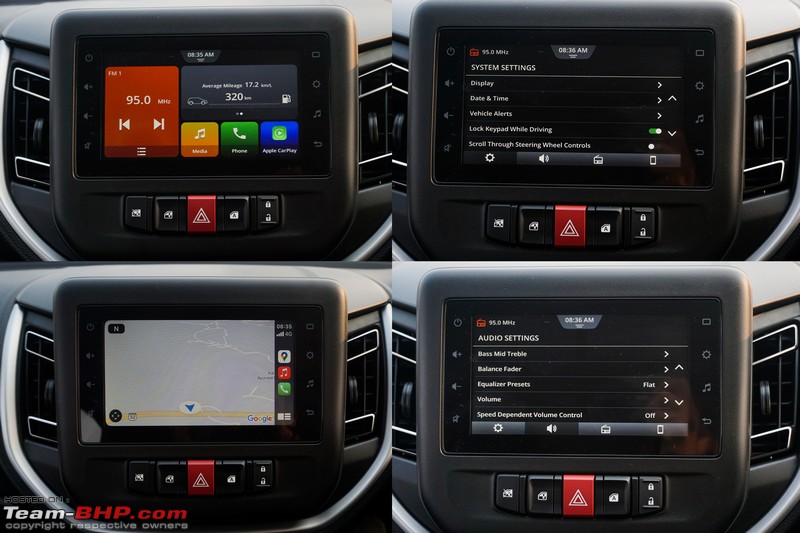 Manual air conditioning is offered on all the variants. Air-con controls are basic and the defogger and compressor buttons are tiny. They can be operated without taking your eyes off the road only after getting used to it. The manual slider for the fresh air and recirculation modes looks outdated. We couldn’t test the effectiveness of the AC during our test drive in Udaipur as the average temperature was in the range of 12 degrees:  12V socket along with USB and Aux-in ports get plastic covers. Below, you get an open cubby hole where you can keep your smartphone and you also get two cupholders:  Black gear knob is nice to hold. While it gets a leather boot, a chrome/silver ring could have been provided to make it look classy:  AMT gear knob has an interesting design and is nice to hold. Good to see that Maruti hasn’t just lifted the gear lever from one of its other cars. This one actually looks good and has nice detailing too:  AMT shifter has a piano black console with a thick silver outline:  The glovebox is well sized and can hold a few things other than just the documents:  A single cabin lamp is placed in the front. If there's only one cabin lamp, it's best placed in the roof's centre and not here at the front. Bluetooth mic positioned in line with the IRVM and cabin lamp:  Just like the front, the rear door pads are also all-black:  Rear door pockets can also accommodate 1-litre bottles and some knick-knacks:  Enough legroom here for two average-sized adults to sit behind each other: 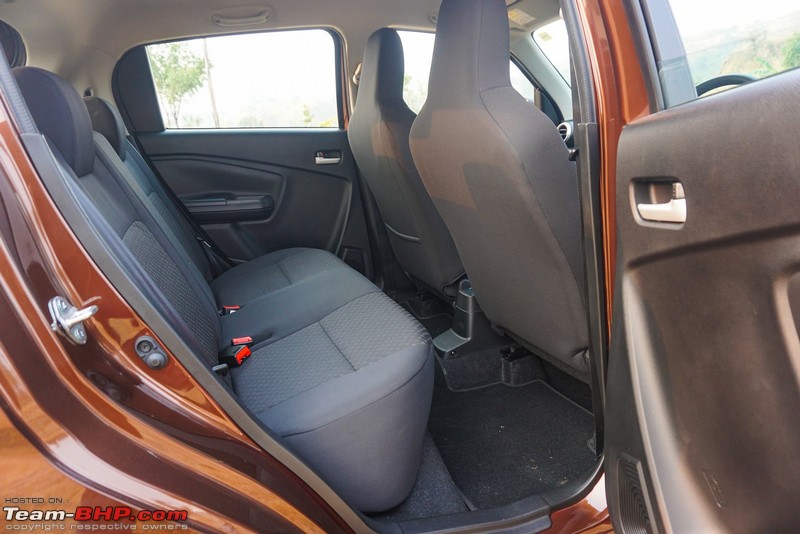 The rear seat is wider than the previous generation car and can seat 3 better. Even then, it's best suited for two adults and a kid. Seat base and the backrest are almost flat with minimal contours: 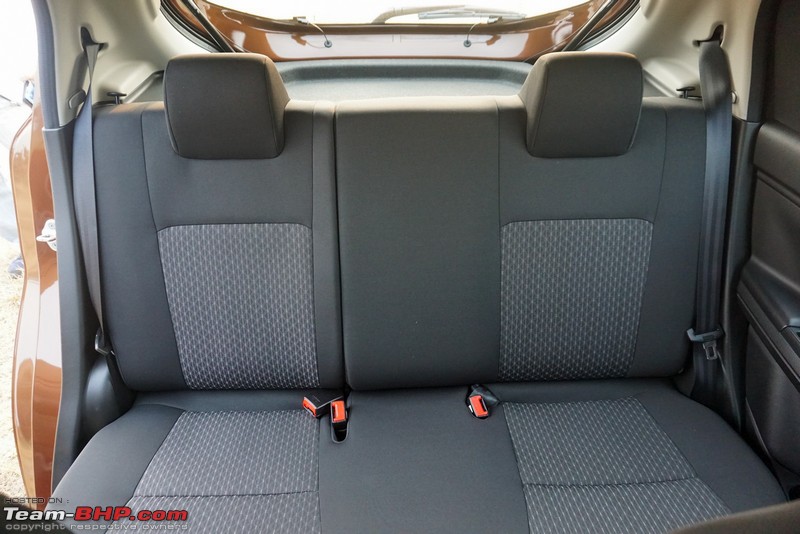 Both side occupants get fixed headrests, which are useless especially for taller folks. Maruti should have offered adjustable headrests for the rear passengers. Nothing for the middle occupant: 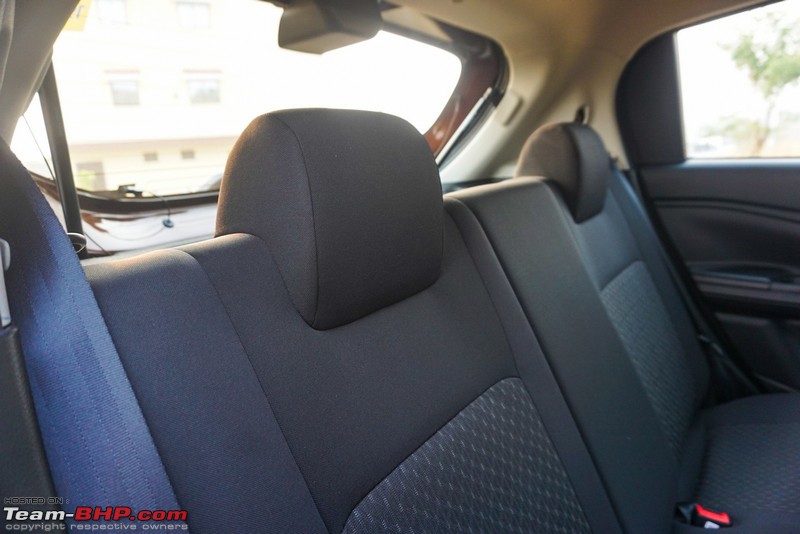 Zappo at 5'8" had enough legroom behind his driving position. The backrest angle is comfortable and the seat base offers good under-thigh support. There’s a healthy amount of headroom as well: 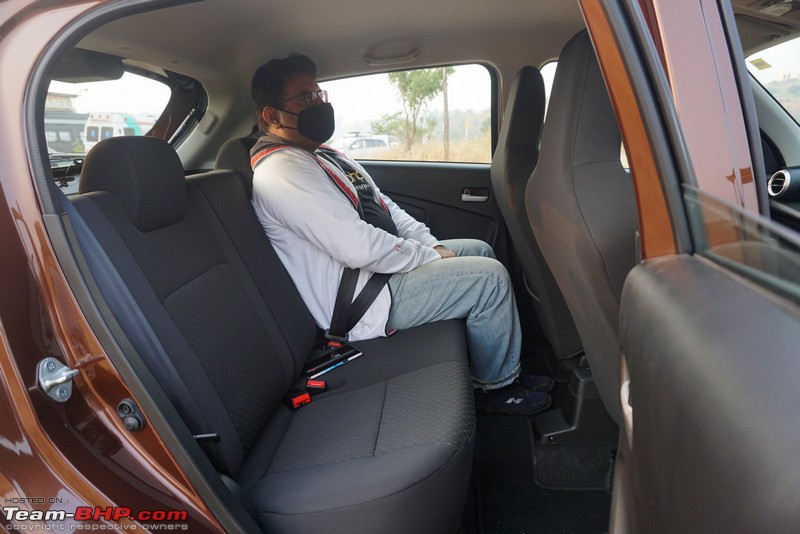 Power window switches for the rear windows have been placed in between the front seats, behind the handbrake. This positioning will take some time to get used to: 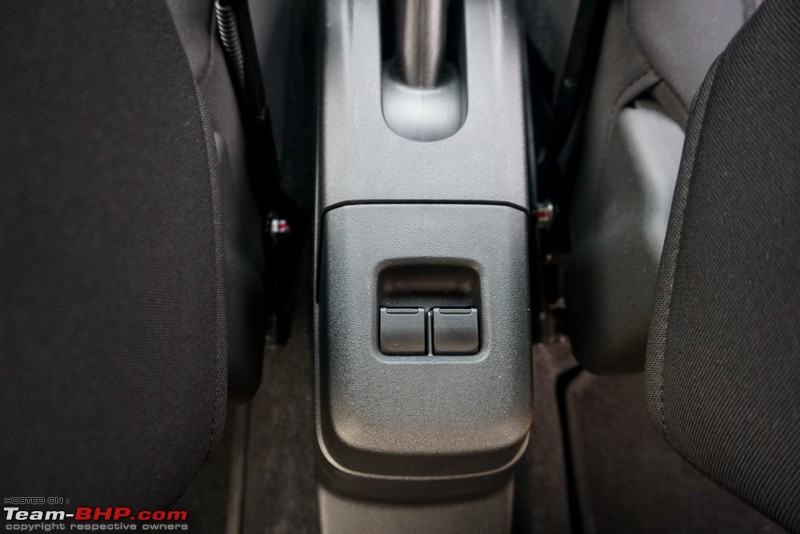 Parcel tray gets raised borders to keep stuff kept on it from rolling onto the rear seat: 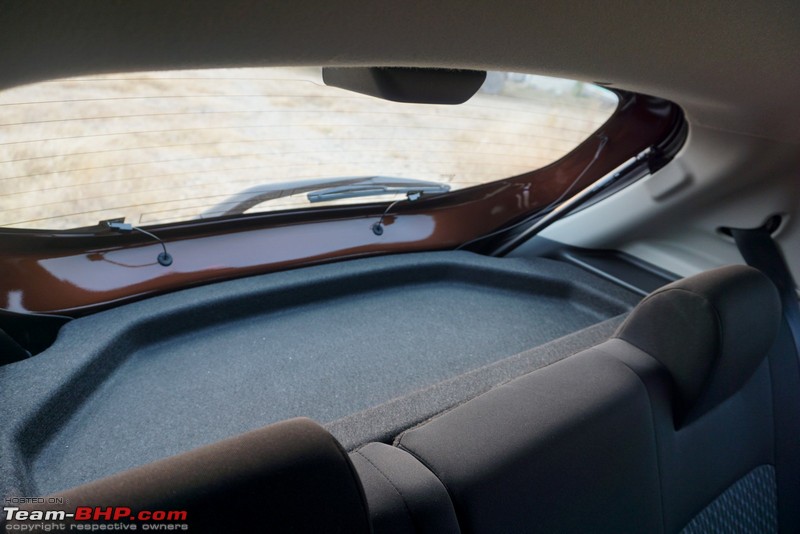 Tailgate opens to a decent height and is easily reachable for most people: 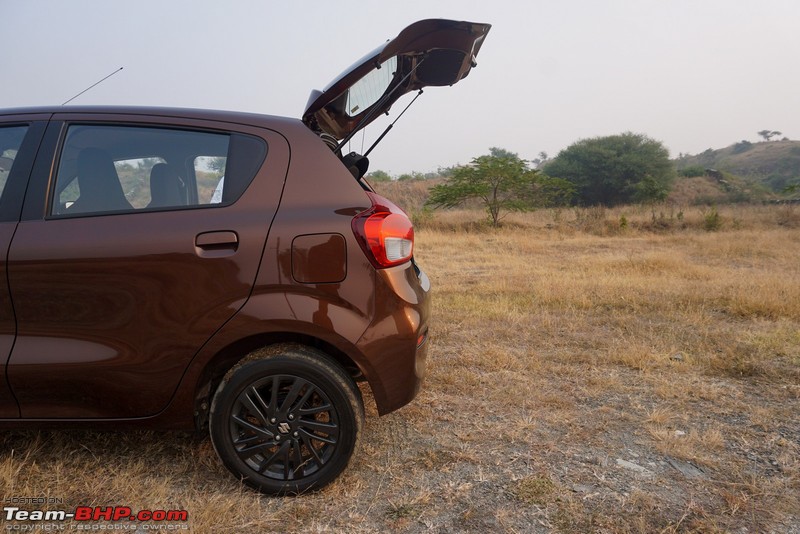 At 313 litres, this is a well-sized boot: 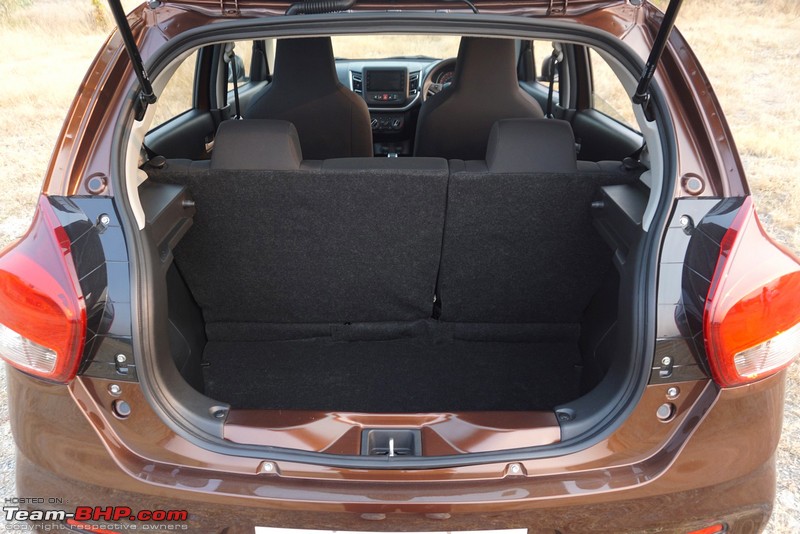 Rear seats can be folded in a 60:40 ratio. Except for base LXi, all other variants get this feature:  The spare wheel is a 14-inch steel rim with 165/70 section tyre (also the tyre size for lower variants): 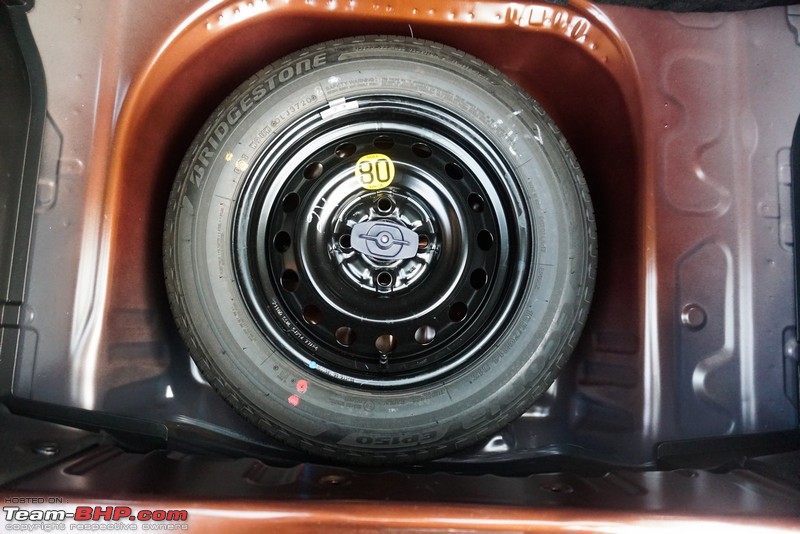 Tailgate gets carpet cladding to hide the mechanical bits. On the other hand, the exposed defogger is a sore sight. Also, check out how high the loading lip is from the boot floor. You will have to make an extra effort to load luggage: 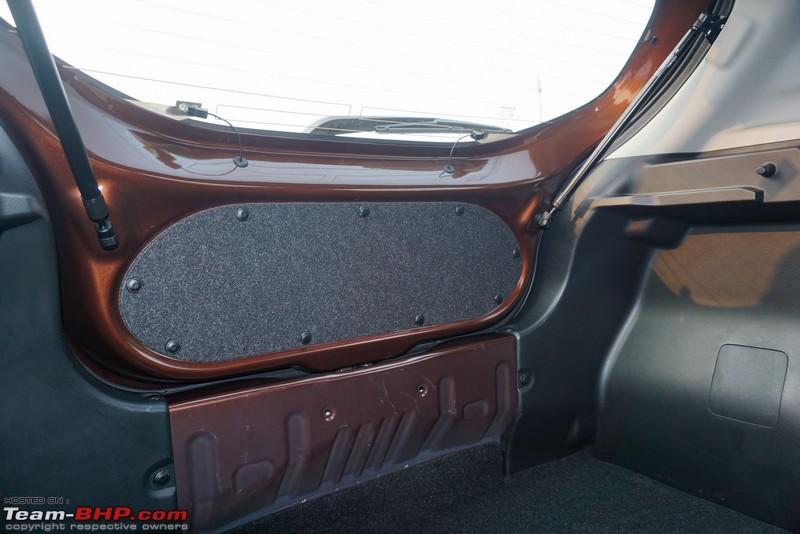 Disclaimer: Maruti invited Team-BHP for the Celerio test-drive. They covered all the travel expenses for this driving event. Last edited by Aditya : 17th November 2021 at 14:19. |
| |  (55)
Thanks (55)
Thanks
 |
| The following 55 BHPians Thank Omkar for this useful post: | AheadAJ, Akshay6988, androdev, Arnav Vaghela, ashis89, CARDEEP, catchjyoti, CEF_Beasts, chaotic, chinmaypillay, CrAzY dRiVeR, deep_behera, Dr.Naren, dsuman, FlashMustang, Gannu_1, GaryTSI, gischethans, GrammarNazi, GTO, g_sanjib, Hrishi_111, icar, jeetumg27, jmjmec, Kpzonwheels, Leoshashi, mh09ad5578, MSAneesh, muqtaliff, nmenon, Prakritij, PraNeel, RaceHorse, RavenAvi, Reinhard, Researcher, ron178, Roy.S, Rshreyansh, S.MJet, samaspire, SatishBisht, SchumiFan, shancz, shibujp, Sivacar, sups, syed_cdp, theexperthand, The_Outsider!, vb-saan, Vignesh Vee, wishnipon, ysjoy |
| | #5 |
| Team-BHP Support  | Thread moved out from the Assembly Line. Thanks for sharing! Last edited by Aditya : 17th November 2021 at 09:04. |
| |  (6)
Thanks (6)
Thanks
 |
| The following 6 BHPians Thank Aditya for this useful post: | Akshay6988, CrAzY dRiVeR, FlashMustang, GTO, Reinhard, Researcher |
| | #6 |
| Senior - BHPian Join Date: Oct 2010 Location: Bangalore
Posts: 1,813
Thanked: 5,864 Times
| Re: 2021 Maruti Celerio Review The biggest competitors of the new Celerio are it's stablemates - WagonR & Ignis. I would put the both the WagonR & Ignis above the Celerio, simply because: - they offer better choice of engines. - they have more space on the inside. - they have better integration of features (Power windows on doors, Proper Request sensor integration etc.) i.e. none of cheap compromises that the Celerio has. In term of appearance, this is like a SugarFree Digestive Biscuit (Doesn't taste very good, but doesn't harm you either). |
| |  (16)
Thanks (16)
Thanks
 |
| The following 16 BHPians Thank abhishek46 for this useful post: | AheadAJ, Akshay6988, Carma2017, chinmaypillay, GaryTSI, GipsyDanger, giri1.8, LaRoca, mh09ad5578, Piyush Kanthak, ramnaresh_2000, RavenAvi, rj22, sainyamk95, Shreyans_Jain, wolfsnare24 |
| | #7 | |
| Senior - BHPian Join Date: Oct 2007 Location: Seattle/Pune
Posts: 1,218
Thanked: 4,920 Times
| Re: 2021 Maruti Celerio Review Clearly designed to sell a million units, it is intriguing to see MS putting in extra-ordinary (by their lousy standards) efforts in designing a damn AMT shifter. Quote: I am kinda sad that the Celerio has lost its personality and now is just a love child of Alto and Swift. Didn't the previous version, in X guise look much better? 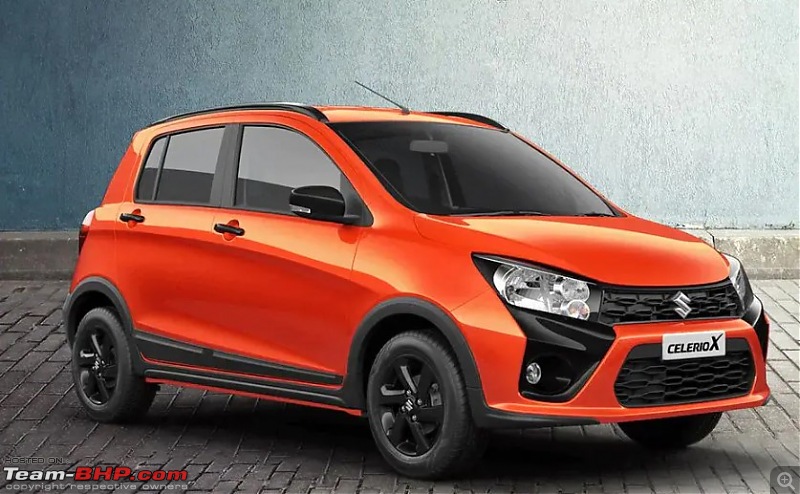 | |
| |  (24)
Thanks (24)
Thanks
 |
| The following 24 BHPians Thank amol4184 for this useful post: | aaychat, AheadAJ, Akshay6988, chinmaypillay, Gamerk, GaryTSI, haisaikat, John, Mahesh Prasad, mh09ad5578, mpthy, Piyush Kanthak, Rahul Bhalgat, RavenAvi, Researcher, Rshreyansh, sainyamk95, SatishBisht, syed_cdp, TheHelix0202, turbowhistle, v12, whitewing, wishnipon |
| | #8 |
| Senior - BHPian Join Date: May 2019 Location: Kozhikode
Posts: 1,229
Thanked: 5,517 Times
| Re: 2021 Maruti Celerio Review I was never a fan of the previous generation Celerio design. I feel this design is better than the previous generation. As mentioned in the post, I think this is squarely aimed at Tiago which has established itself as a powerful brand. They needed a fresh design to at least get into the consideration set of Tiago customers. That could be the reason they went for a major change rather than an evolutionary one over the previous Celerio. Everything else is the usual Suzuki package. People who value the peace of mind and service support of Suzuki will choose this over Tiago. |
| |  (2)
Thanks (2)
Thanks
 |
| The following 2 BHPians Thank padmrajravi for this useful post: | SatishBisht, slango97 |
| | #9 |
| Distinguished - BHPian  | Re: 2021 Maruti Celerio Review Thanks for the detailed review  I didn't like the looks of new Celerio initially. But the car in red and blue shades really looked good. It's nice to know that new generation AMT is doing better. I would TD the car soon and plan to replace my Kwid 0.8 MT with Celerio ZXI+ AGS  . . |
| |  (3)
Thanks (3)
Thanks
 |
| The following 3 BHPians Thank Dr.Naren for this useful post: | AkMar, nmenon, samaspire |
| | #10 |
| Distinguished - BHPian  Join Date: Nov 2013 Location: HR51/HR29/HR26
Posts: 2,758
Thanked: 21,240 Times
| Re: 2021 Maruti Celerio Review Requesting the team to test the CNG variant as well, treating it like a separate engine option. Very relevant and much needed in these times of high petrol price and high demand of company fitted CNG cars. |
| |  (6)
Thanks (6)
Thanks
 |
| The following 6 BHPians Thank Shreyans_Jain for this useful post: | Akshay6988, headbanger, LaRoca, PaddleShifter, rkv_2401, sainyamk95 |
| | #11 |
| BHPian Join Date: Jul 2019 Location: Chennai
Posts: 462
Thanked: 2,169 Times
| Re: 2021 Maruti Celerio Review This just firms up my belief that Ignis is the most VFM product in the sub Million rupee bracket. If Maruti chooses to update the current AMT gearbox in Ignis with the one reviewed here, Hyundai will lose their title as the " Best AMT " gearbox provider ! |
| |  (4)
Thanks (4)
Thanks
 |
| The following 4 BHPians Thank Sk8r for this useful post: | GaryTSI, jithin23, RavSam, Sumer |
| |
| | #12 | |||
| BHPian Join Date: Jan 2019 Location: TN-11, AP-03
Posts: 942
Thanked: 2,429 Times
| Re: 2021 Maruti Celerio Review Nice review of the new kid in the block. This is going to create a competition with in and Tiago doesn't seems to be hurt. The market sentiment is with TATA and crash ratings of other TATA cars will help its way to Tiago. The new one seems to have added gizmos and those 15" inch wheels are really cool. Quote:
Quote:
The positioning seems to be odd. Or is it for practicality? Quote:
Last edited by saisree : 17th November 2021 at 11:30. | |||
| |  (2)
Thanks (2)
Thanks
 |
| The following 2 BHPians Thank saisree for this useful post: | Roy.S, wishnipon |
| | #13 | |
| BHPian Join Date: Feb 2021 Location: Pune
Posts: 68
Thanked: 119 Times
| Re: 2021 Maruti Celerio Review Quote:
 Any specific reason there wasn't 'What you'll like/won't like' section at the top? It is quite a good summary for the car. | |
| |  (8)
Thanks (8)
Thanks
 |
| The following 8 BHPians Thank red_nemesis for this useful post: | AkMar, GaryTSI, giri1.8, LaRoca, samaspire, samy1117, Shreyas, Sumer |
| | #14 |
| Senior - BHPian | Re: 2021 Maruti Celerio Review I am guessing that the other existing Maruti 1.0 engine models will get this updated 1.0 engine too. Looks like Maruti is stressing on the fuel efficiency part of this new car with the current fuel costs. Any idea what would be the real world efficiency of this car in city traffic? |
| |  ()
Thanks ()
Thanks
 |
| | #15 |
| Senior - BHPian Join Date: Nov 2015 Location: Mumbai
Posts: 1,223
Thanked: 3,807 Times
| Re: 2021 Maruti Celerio Review Strictly speaking, the Celerio is the more premium car when compared to the WagonR, both inside out. But this 'premiumness' is diluted by some weird ergonomic decisions by Maruti like the central placement of the power window switches. But then, even the Santro has the power window switches in the center console and you rarely find people saying that the Santro is less premium than the WagonR. The main issue with the Celerio is highlighted when you talk about the engine. You can buy an Ignis Delta or the WagonR 1.2 VXI for the price of the Celerio VXI. You can also get the Ignis Zeta, the WagonR 1.2 ZXI or the Grand i10 Magna for the price of the Celerio ZXI. All the above cars have a superior engine than the Celerio. I guess that the Celerio will be sold to the folks looking for the newest Maruti in the town while not caring much about the engine, which means that this product is still going to be a hit. Last edited by AYP : 17th November 2021 at 11:37. |
| |  (3)
Thanks (3)
Thanks
 |
| The following 3 BHPians Thank AYP for this useful post: | Hrishi_111, saion666, theAutomaniac |
 |







